My Doomed Attempt To Make Jjajangmyeon At Home
by Ben Choi
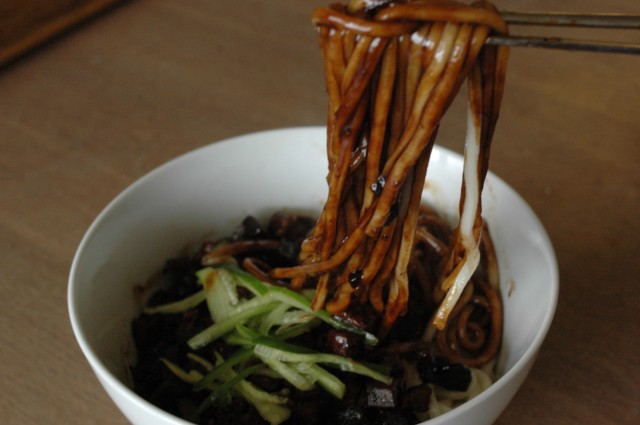
A series about foods we miss and our quests to recreate them.
When I was little my father used to take me and my brothers into L.A.’s Koreatown after Korean Church. We would often stop by the Joonggook jip (Korean-Chinese restaurant) for a steaming bowl of my favorite lunch, jjajangmyeon, a roasted black soybean sauce served over hand-pulled thick wheat noodles. My father would always tuck a paper napkin under my chin, since the inky sauce was liable to leave flecky dark-brown stains on my white Sunday shirt.
Now I’m grown, and I no longer feel comfortable wearing a makeshift bib in public. To avoid visible stains I always wear black when I go out for jjajangmyeon. Wearing black is doubly a propos, because I’ve begun mourning over the inevitable decline of this tasty noodle dish. In its most authentic form at least, the lost food I feel so nostalgic for is heading quickly towards being truly lost — towards extinction.
I know I’m being a little dramatic. Jjajangmyeon is one of the most popular foods in Korea and in Koreatowns across the globe. It’s the number-one South Korean delivery/takeout food, as omnipresent as pizza is in the U.S. But I’ve found it harder and harder to find a good bowl of it, and, by my observation, jjajangmyeon has changed over the years. It used to be a cultural touchstone, a manifestation of the best parts of assimilation. Chinese immigrants adapting their cuisine to fit the tastes of their valued Korean customers. Now it’s perceived as a Korean dish, and it’s being served up primarily by Koreans. What used to be a process has become an endpoint, a product. Imagine going into typical American-Chinese takeout place and seeing some white guy manning the wok. When the last ethnic Chinese chef who was trained in Korea hangs up his apron, that’s where we’ll be.
In setting out to recreate my childhood favorite, I know I’m doomed to failure. At its heart jjajangmyeon is immigrant street food, and my homemade version is bound to be, like me, too Korean and too American. I’m certainly not going to be able to hand-pull the noodles, or ferment and roast the soybeans for the sauce. I’m relying on store-bought Korean products, so it’s on the flavor details and textural niceties I’m going to concentrate. In the end, though, I’m just like that white guy slinging General Tso’s chicken.
Here’s a little historical background on jjajangmyeon. Immigrants from China’s Shandong province brought their distinctive food culture to Korea about a century ago, during the time of Japanese rule. Over three generations, a legendary hybrid cuisine was developed in the lunchrooms and take-out joints run by these culinarily gifted ethnic Chinese Koreans, and Korean-Chinese food became extremely popular. Unfortunately, in the 1960s and 1970s, under Park Jung-Hee’s military dictatorship, Chinese Koreans were heavily discriminated against, having to contend with laws that limited or outright eliminated their rights to own property, and run businesses. The majority of ethnic Chinese in Korea were forced to migrate, once again, this time mostly to the United States and Taiwan. In the United States, many of these two-time emigres opened Korean-Chinese restaurants in the burgeoning Korean communities of Los Angeles, Chicago, New York City, and Fort Lee, New Jersey. There are some that will tell you that the best Korean-Chinese food is American Korean-Chinese food, and I’m inclined to agree. I’ve always suspected I got in on the good stuff.
What makes jjajangmyeon great is what separates it from other Korean food. Korean food is known for bold, distinct flavors and textures, but jjajangmyeon’s gustatory effect is subtle and cumulative. The salty and slightly sweet sauce, with its little chewy tidbits of meat and vegetables, forms caramelly whole which complements the freshness and softness of the noodles. There’s also a lot less meat here than you’ll find in most restaurant Korean food. And, heck, there isn’t even very much garlic in it.
I’m a bit of a purist about jjajangmyeon. And though I accept that non-Asians can excel at martial arts, I have the conviction that only ethnic Chinese living among Koreans can make great jjajangmyeon. My Korean homies’ll spice it up too much, or make the noodles too firm. Chinese nationals who have not lived in Korea may have the noodle skills, but will lack the insider understanding of the Korean palate. There are, though, fewer Korean-Chinese folks around than there used to be. As we move further from the generations of Korean Chinese that created this dish, fewer of their children will go into the family business, and all that good double-diaspora know-how will go into engineering and finance rather than noodles. Hand-pulled noodles are available in only a handful of joonggook jip in any city I’ve been.
I really feel a sense of loss. The once-thrilling build-up that used to accompany trying a new jjajangmyeon joint has been displaced by a cycle of disappointment not unlike following the mating difficulties of giant Pandas at the zoo. “The sauce is watery at that new place. Ooh, and Pei-Pei has given Ling-Ling a nasty bite on the leg.”
On the bright side, decent homestyle jjajangmyeon is much easier to come by nowadays. The decline of the great, from-scratch, genuine article in restaurants has definitely correlated with an increase in the availability of black-bean paste of quite good quality (I recommend Cheong Jeong Weon (청정원) and Haechandle (해찬들)) and passable factory-made noodles. These allow you to make jjajangmyeon at home that rivals what you’ll find in many restaurants today. In fact, this might be how most places make it now.
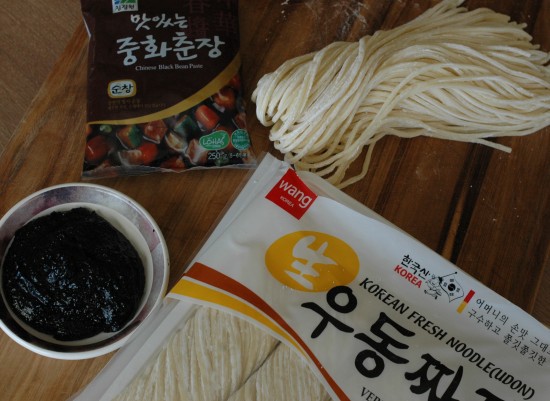
I wound up making this recipe three separate times, modifying as I went along. Here are a few things I learned from all the trial and error:
• Uniformity and size of dice is very important. Even ½-inch pieces feel a bit large and tough.
• Definitely make sure to pre- fry the black bean paste. It totally makes the flavor more subtle and complex.
• Don’t use too much starch. It dulls the flavor, and an overly thick sauce won’t adhere to the noodles in the right way.
• Use the right kind of noodles. I experimented with knife-cut and Shanghai style noodles. Definitely use Korean noodles that are specifically for jjajangmyeon. (I know the package says “udon,” but the Korean writing beneath it also says “jjajang.”)
• Quick-rinse the noodles and drain well. Leaving too much surface starch or extra water on them adversely affects how the sauce adheres.
• Definitely finish with sugar and sesame oil. It tempers the saltiness of the sauce.
I was pretty pleased with the recipe I arrived at. It’s about as good as you’ll find in many restaurants. The noodles don’t come close to hand-pulled, or even freshly made machine-cut ones, but they mate with the sauce rather nicely. The sauce is actually quite good. The veggies and meat are about the right firmness, and the flavor and texture come pretty close to the mark.
HOMESTYLE JJAJANGMYEON
(Serves 4)
1 tsp. peanut oil
½ tsp. sesame oil
4 tbsp. Korean black bean paste
1 tsp. peanut oil
½ tsp. sesame oil
½ lb. pork country rib, diced
1 tsp. peanut oil
½ tsp. sesame oil
1 medium white onion (about 1 cup), diced
2 small zucchini (about ½ cup), diced
Korean white radish (about ½ cup), diced
2 cups water
1 tbsp. potato starch dissolved in 1 tsp. water
2 tsp. brown sugar
½ tsp of sesame oil for drizzling
1 Persian cucumber, cut into thin matchsticks
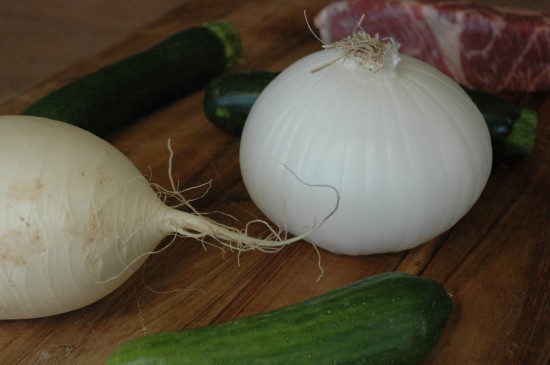
Heat peanut oil and sesame oil together in a small nonstick skillet over medium high heat to shimmering. Stir in black bean paste, combining thoroughly with hot oil. Heat while stirring constantly for about 2 or 3 minutes. Set aside.
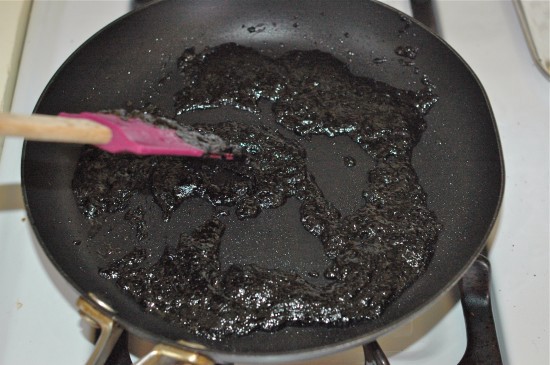
Chop pork and all non-onion and non-cucumber vegetables into ⅓-inch dice. You’re aiming for a high level of uniformity in the pieces, so use a very sharp knife.
You want to discard the seeded portion of the zucchini. To do this chop off both ends and slice in half lengthwise, and then slice each half lengthwise again. This creates a 90-degree triangular prism of seeds. Cut it out.
Onions are round, so it will not be possible to get totally uniform pieces, so aim for a ½-inch wide dice at the surface of the onion that way, the pieces will average about ⅓ inch. Cut the cucumber into 2-inch matchsticks.
To brown the pork, heat peanut and sesame oils together in a wok over high heat, to shimmering. Brown pork to about what would be a medium-steak level of doneness.
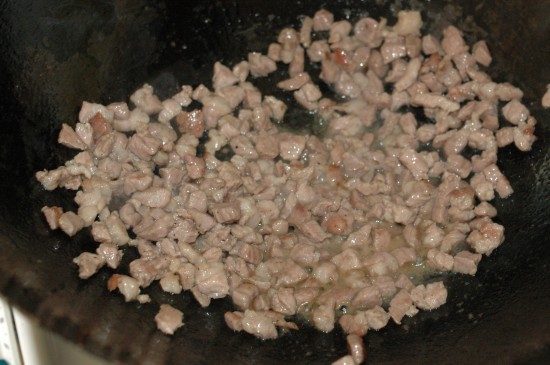
Carefully remove the pork and set aside, leaving as much rendered pork fat and oils in the wok as possible.
Add Korean radish to hot fat, stirring intermittently but vigorously for 3 minutes. Now add onion and give it the same treatment for 2 minutes. Add the zucchini for just about a minute. Finally re-incorporate the pork to the vegetable mix.
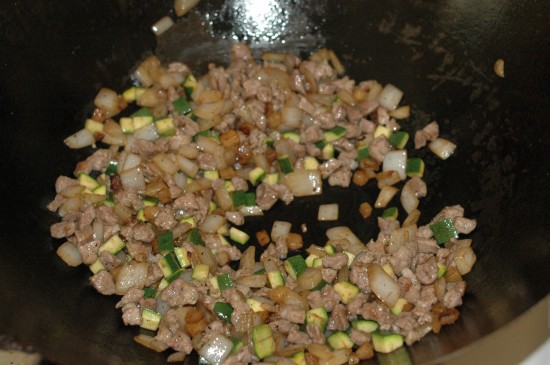
Add water and the black bean paste you fried earlier. Combine well and bring to a boil.
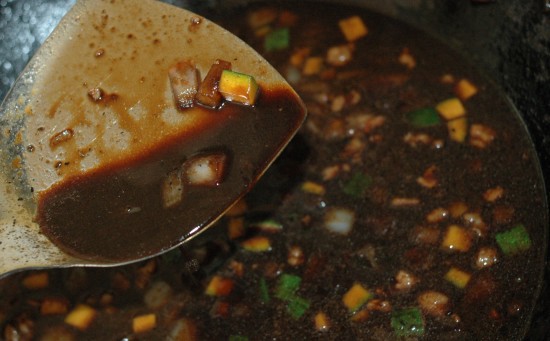
When sauce reaches a healthy simmer, add potato starch slurry.
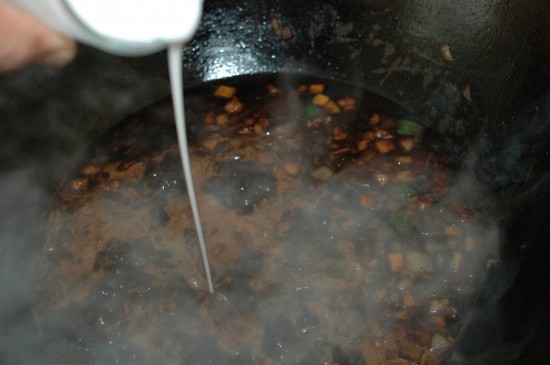
Lower heat to medium and let the sauce thicken to the consistency somewhere between half-and-half and cream.
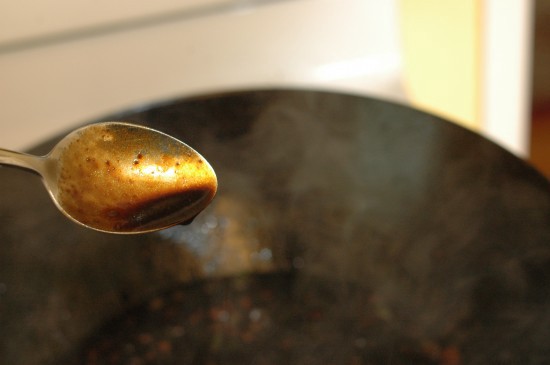
Stir in the brown sugar and finish the sauce with a drizzle of sesame oil, about a half-teaspoon.
For the noodles, bring a couple of quarts of water and a healthy pinch of salt to rolling boil. Add about 3 servings of the jjajang noodles, as this should translate to about 4 normal servings. Boil for about 3 to 4 minutes. The noodles should be considerably softer than al dente pasta, but still have some elastic bite to them. Rinse quickly under cold water for just a second or two. You want to get rid of some of the surface starch, but keep the noodles warm. Drain well and portion into bowls. Top liberally with jjajang and garnish with cucumber.
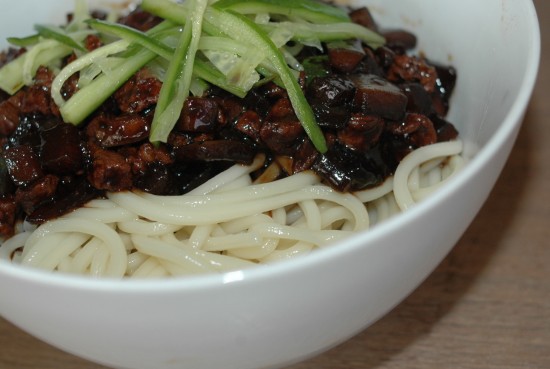
So there you have it. Homestyle jjajangmyeon. Please enjoy. But if there’s a well-regarded Korean-Chinese restaurant near you, I encourage you to seek it out and try the traditional version. Just remember to wear black.
Previously: My Attempt To Make The Perfect Nebraska Runza, How To Enjoy A Beef On Weck When You’re Not In Buffalo and How To Enjoy A Pasty When You’re Not In North Michigan
Ben Choi, who writes this site’s Search For The Next Sriracha column, lives in the Bay Area with his wife Erica and dog Spock.
